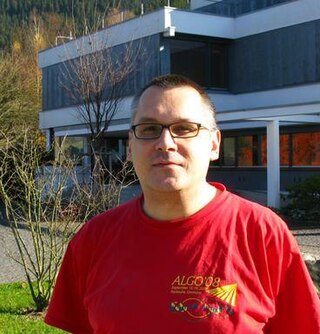Related Research Articles
Plankalkül is a programming language designed for engineering purposes by Konrad Zuse between 1942 and 1945. It was the first high-level programming language to be designed for a computer.

Carl Adam Petri was a German mathematician and computer scientist.

The Z1 was a motor-driven mechanical computer designed by German inventor Konrad Zuse from 1936 to 1937, which he built in his parents' home from 1936 to 1938. It was a binary, electrically driven, mechanical calculator, with limited programmability, reading instructions from punched celluloid film.

The Gottfried Wilhelm Leibniz Prize, or Leibniz Prize, is awarded by the German Research Foundation to "exceptional scientists and academics for their outstanding achievements in the field of research". Since 1986, up to ten prizes have been awarded annually to individuals or research groups working at a research institution in Germany or at a German research institution abroad. It is considered the most important research award in Germany.

Kurt Mehlhorn is a German theoretical computer scientist. He has been a vice president of the Max Planck Society and is director of the Max Planck Institute for Computer Science.

Manfred Broy is a German computer scientist, and an emeritus professor in the Department of Informatics at the Technical University of Munich, Garching, Germany.

Susanne Albers is a German theoretical computer scientist and professor of computer science at the Department of Informatics of the Technical University of Munich. She is a recipient of the Otto Hahn Medal and the Leibniz Prize.

In geometric graph theory, a branch of mathematics, a matchstick graph is a graph that can be drawn in the plane in such a way that its edges are line segments with length one that do not cross each other. That is, it is a graph that has an embedding which is simultaneously a unit distance graph and a plane graph. For this reason, matchstick graphs have also been called planar unit-distance graphs. Informally, matchstick graphs can be made by placing noncrossing matchsticks on a flat surface, hence the name.

Reinhard Wilhelm is a German computer scientist.
Jan van Leeuwen is a Dutch computer scientist and emeritus professor of computer science at the Department of Information and Computing Sciences at Utrecht University.
The German Informatics Society (GI) is a German professional society for computer science, with around 20,000 personal and 250 corporate members. It is the biggest organized representation of its kind in the German-speaking world.
The Konrad Zuse Medal for Services to Computer Science is the highest award of the Gesellschaft für Informatik, given every two years to one or sometimes two leading German computer scientists. It is named after German computer pioneer Konrad Zuse. Note that a different medal with the same name is also given out by the Zentralverband des Deutschen Baugewerbes.

Matthias Jarke was a German computer scientist.
Leif Kobbelt is a German university professor for Computer Science with a specialization in Computer Graphics. Since 2001 he is the head of the Institute for Computer Graphics and Multimedia at RWTH Aachen university.
Klaus Pohl is a German computer scientist and Professor for Software Systems Engineering at the University of Duisburg-Essen, mainly known for his work in Requirements Engineering and Software product line engineering.
Gunther Schmidt is a German mathematician who works also in informatics.

Gerhard J. Woeginger was an Austrian mathematician and computer scientist who worked in Germany as a professor at RWTH Aachen University, where he chaired the algorithms and complexity group in the department of computer science.

Thomas Lengauer is a German computer scientist and computational biologist.
Martin Grohe is a German mathematician and computer scientist known for his research on parameterized complexity, mathematical logic, finite model theory, the logic of graphs, database theory, descriptive complexity theory, and graph neural networks. He is a University Professor of Computer Science at RWTH Aachen University, where he holds the Chair for Logic and Theory of Discrete Systems.

The Department of Computer Science is a department of the Technische Universität Darmstadt. With a total of 36 professorships and about 3,700 students in 12 study courses, the Department of Computer Science is the largest department of the university. The department shapes the two research profile areas "Cybersecurity (CYSEC)" and "Internet and Digitization (InDi)" of the university.
References
- 1 2 GI-Fellow citation Archived 2011-08-13 at the Wayback Machine , retrieved 2012-03-09.
- ↑ Faculty profile, KIT, retrieved 2012-03-09.
- 1 2 Curriculum vitae, retrieved 2012-03-09.
- ↑ Dorothea Wagner at the Mathematics Genealogy Project
- 1 2 Scientific activities Archived 2016-09-08 at the Wayback Machine , retrieved 2012-03-09.
- ↑ Zuber-Knost, Elisabeth (July 16, 2007), Karlsruher Professorin ist DFG-Vizepräsidentin (in German), Informationsdienst Wissenschaft .
- ↑ Journal of Discrete Algorithms home page, retrieved 2012-03-09.
- ↑ OASIcs editorial board, retrieved 2012-03-09.
- ↑ Tilmann Warnecke (July 1, 2019), Präsidentenwahl: Dreikampf um die DFG-Spitze Der Tagesspiegel .
- ↑ Google Focused Research Award citation, retrieved 2012-03-014
- ↑ Member profile: Dorothea Wagner, Academia Europaea , retrieved 2015-09-18.
- ↑ "Konrad-Zuse-Medaille: Dorothea Wagner erhält höchste Informatik-Auszeichnung", Gesellschaft für Informatik (in German), August 14, 2019.